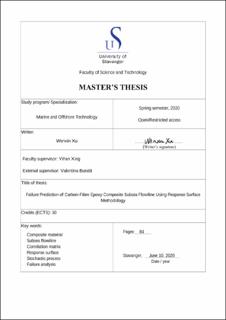| dc.description.abstract | Carbon Fibre Epoxy Composite is a relatively new material utilized in the subsea oil and gas industry. The fibre reinforced composite is competitive for its high strength-to-weight ratio and good corrosion resistance. This thesis addresses the stochastic process applied to the CFEC flowline using response surface methodology. The material properties, geometries, and loadings are considered as the input parameters of the finite element model of the CFEC flowline, while failure criteria are output parameters. To have a better understanding of which parameter will affect the results, studies of correlation matrices are performed. Input parameters with higher correlation coefficients are identified and chosen to generate the response surfaces. A stochastic process which requires the large size of “measured results” can be substituted by approximate “response values”. The accuracy of the response surface is an essential issue that determines whether the approximate results are meaningful. Many factors that will affect the quality of the response surfaces, i.e. response surface type, number of selected parameters, size of the response surface, etc. Comparison studies about these possible factors are discussed in this thesis.
It is found that parameters that have correlation coefficients larger than a level should be selected for response surface generation. More parameters selected will increase both the time of generating response surface and the accuracy, while if extremely few parameters are selected, i.e. five, the accuracy will be significantly affected. Larger response surface size will slightly reduce the accuracy of response values, so the use of larger size becomes available, which can be utilized by more design cases. It is noted that the sample populations should avoid centralized at the boundary of response surfaces. With these approaches, the efficiency of using the response surface methodology in composite flowline design can be improved, where the percentage differences of predicted exceeding probabilities are usually below 10%. Based on these findings, a safety factor can be defined and used to describe these uncertainties. | en_US |
